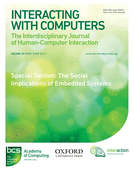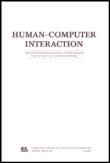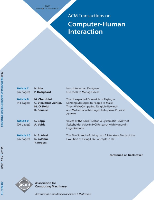
Multimodal Technologies and Interaction
Scope & Guideline
Exploring the Future of User Experience.
Introduction
Aims and Scopes
- Multimodal Interaction Design:
The journal explores how multiple sensory modalities can be effectively combined to create richer interaction experiences, particularly in virtual and augmented reality environments. - Educational Technology Integration:
Research on the application of multimodal technologies in educational settings is a core focus, investigating how these tools can enhance learning outcomes and engagement. - Health and Rehabilitation Technologies:
The journal addresses the use of multimodal technologies in health contexts, including rehabilitation tools and methods to support cognitive and physical health. - User Experience and Usability Studies:
A significant emphasis is placed on user-centered design, evaluating how users interact with multimodal systems and the effectiveness of these interactions. - Cultural Heritage and Community Engagement:
The journal also covers how multimodal technologies can facilitate the preservation and sharing of cultural heritage, fostering community involvement and education. - Human-Robot Interaction:
Research is conducted on the dynamics of human-robot interactions, focusing on how multimodal feedback can enhance communication and usability.
Trending and Emerging
- Immersive Learning Environments:
There is a rising trend in developing immersive learning experiences using augmented and virtual reality, aimed at enhancing engagement and retention in educational contexts. - AI and Machine Learning Integration:
The integration of artificial intelligence and machine learning techniques into multimodal systems is gaining traction, particularly for personalized user experiences and adaptive learning. - Wellness and Therapeutic Applications:
Emerging research focuses on the use of multimodal technologies for wellness and therapeutic applications, including cognitive rehabilitation and mental health support. - Interactive Cultural Heritage Experiences:
The field is increasingly exploring how multimodal technologies can enhance the accessibility and engagement of cultural heritage, allowing for richer visitor experiences. - Social and Emotional Interaction Design:
New studies are delving into the design of socially and emotionally responsive systems, particularly in human-robot interactions and educational settings.
Declining or Waning
- Traditional User Interface Design:
There appears to be a waning emphasis on conventional user interface design methodologies as the field moves towards more immersive and engaging multimodal experiences. - Physical Interaction with Digital Content:
Research on purely physical interactions, such as touch-based interfaces without multimodal feedback, has decreased as the integration of sensory modalities becomes more prevalent. - Basic Virtual Reality Applications:
The exploration of basic virtual reality applications, without significant innovations or multimodal enhancements, seems to be declining in favor of more complex, integrated systems. - Static Educational Tools:
There is a noticeable reduction in studies focusing exclusively on static educational tools, as the field shifts towards dynamic, interactive learning environments. - Single-Modal Therapeutic Approaches:
Research concentrating on single-modality therapeutic interventions is becoming less common, with a growing preference for multimodal approaches that address diverse user needs.
Similar Journals

Visual Informatics
Leading the Charge in Computer Graphics InnovationVisual Informatics is a premier academic journal published by Elsevier, dedicated to advancing the fields of computer graphics, computer-aided design, and human-computer interaction. Since its launch in 2017, this Open Access journal has swiftly established itself as a leading platform for innovative research, reflected in its impressive impact factor and robust rankings in various Scopus categories. In 2023, it proudly holds positions in the top quartile (Q1) for Computer Graphics and Computer-Aided Design, Human-Computer Interaction, and Software, showcasing its influential contributions to these dynamic fields. Based in Amsterdam, Netherlands, Visual Informatics encourages the dissemination of high-quality, peer-reviewed articles that explore the intersection of visual technology and user experience, serving as an invaluable resource for researchers, professionals, and students seeking to stay at the forefront of these evolving disciplines.

INTERACTING WITH COMPUTERS
Exploring the Intersection of Humans and TechnologyINTERACTING WITH COMPUTERS is a renowned journal published by Oxford University Press, focusing on the interdisciplinary field of Human-Computer Interaction, as well as aspects of Library and Information Sciences and Software. With a rich history of publication since 1989, this journal has established itself as a significant platform for scholars to disseminate cutting-edge research and innovative methodologies that enhance our understanding of how humans engage with technology. Despite being classified in the Q3 and Q2 quartiles across various categories, its 2023 Scopus rankings highlight its relevance, positioning it within the 69th percentile for Library and Information Sciences. This makes it an essential resource for researchers, professionals, and students looking to stay informed about the latest advancements and discussions in this rapidly evolving domain. Though not currently open access, INTERACTING WITH COMPUTERS offers substantial insights that are crucial for driving forward the conversation in Human-Computer Interaction, ensuring its relevance in both academic and applied contexts.

Computers in Human Behavior Reports
Transforming understanding of human-machine interactions.Computers in Human Behavior Reports, published by ELSEVIER, is a distinguished open-access journal dedicated to advancing interdisciplinary research at the intersection of technology and human behavior. Since its inception in 2020, the journal has quickly gained a prominent position in the academic field, attaining Q1 category rankings in multiple areas including Applied Psychology, Artificial Intelligence, Cognitive Neuroscience, Human-Computer Interaction, and Neuroscience (miscellaneous). Its robust standing is evidenced by its exceptional Scopus ranks, particularly in Neuroscience—where it is positioned 4th out of 49 journals—demonstrating a high level of influence and engagement within the community. The journal's aim is to disseminate cutting-edge research findings and foster dialogue among researchers, professionals, and students alike, thereby addressing crucial questions regarding the impact of technology on human behavior and vice versa. As an open-access publication based in the United Kingdom, it not only enhances the visibility of research but also ensures wider accessibility to groundbreaking insights that shape our understanding of human-machine interactions.

HUMAN-COMPUTER INTERACTION
Advancing Interactions Between Humans and TechnologyHUMAN-COMPUTER INTERACTION is a premier academic journal published by Taylor & Francis Inc, dedicated to the interdisciplinary field of HCI, which explores the dynamic interactions between humans and computers. With its ISSN 0737-0024 and E-ISSN 1532-7051, the journal maintains a strong presence within the academic community and is recognized for its significant impact, holding a commendable impact factor that underscores its relevance. Ranked in the Q1 category for both Applied Psychology and Human-Computer Interaction, it occupies a critical position in Scopus rankings, listed as #15 in Applied Psychology and #11 in Computer Science, Human-Computer Interaction, placing it in the top 6% of relevant fields. Covering a broad spectrum of topics from usability studies to user experience design, the journal aims to facilitate innovative research and provide insights that bridge theoretical frameworks and practical applications. Published since 1985 and continuously evolving, HUMAN-COMPUTER INTERACTION remains an essential resource for researchers, professionals, and students eager to contribute to and benefit from advances in understanding how technology can effectively serve human needs.

USER MODELING AND USER-ADAPTED INTERACTION
Elevating User Experience Through Cutting-Edge ResearchUSER MODELING AND USER-ADAPTED INTERACTION, published by SPRINGER, stands as a pivotal journal within the realms of Computer Science Applications, Education, and Human-Computer Interaction. With an ISSN of 0924-1868 and an E-ISSN of 1573-1391, this journal has established a reputable presence since its inception in 1991, continuing to contribute to the scholarly discourse through 2024. With an impressive impact factor reflective of its high visibility, it is ranked in the top quartiles, notably Q1 in both Computer Science Applications and Education, and Q2 in Human-Computer Interaction as of 2023. This positions the journal within the 95th percentile in Social Sciences Education and the 81st percentile in Human-Computer Interaction. As it encompasses a broad scope that integrates user modeling techniques with adaptive interaction strategies, the journal caters to the needs of researchers, professionals, and students keen on advancing knowledge in adaptive technology, educational tools, and user-centric design. While not currently open access, it remains a valuable resource for anyone interested in the intersection of user experience and technological adaptation.

VIRTUAL REALITY
Transforming Insights into Immersive InnovationsVIRTUAL REALITY is a prestigious journal published by SPRINGER LONDON LTD that has been at the forefront of the field since its inception in 1995. This journal, with an ISSN of 1359-4338 and E-ISSN 1434-9957, serves as an indispensable resource for researchers, professionals, and students interested in the rapidly evolving domains of computer graphics, human-computer interaction, and software development. VIRTUAL REALITY holds an impressive Q1 ranking across relevant categories, reflecting its high impact within the academic community, with specific rankings such as 11th overall in Computer Graphics and Computer-Aided Design and 31st in Human-Computer Interaction. This journal aims to publish cutting-edge research that explores theoretical advancements and practical applications related to virtual environments, contributing significantly to knowledge and innovation. With access options available through institutional subscriptions, it continues to shape the landscape of its field and inspire future research in immersive technologies.

Journal of Usability Studies
Exploring the intersection of technology and user satisfaction.The Journal of Usability Studies, published by the USERS EXPERIENCE PROFESSIONAL ASSOCIATION, is a pivotal platform for researchers and professionals dedicated to advancing the field of usability and user experience design. With an ISSN of 1931-3357, this journal offers a collection of peer-reviewed articles that explore innovative methodologies, emerging technologies, and applied research in usability studies. Though it operates under a traditional access model, the journal remains dedicated to fostering a detailed understanding of how users interact with systems and products. The Journal of Usability Studies is instrumental for those aiming to enhance user satisfaction through research-backed insights, making it a vital resource for academics, practitioners, and students seeking to contribute to the evolving discourse in human-computer interaction and usability engineering.

ACM Transactions on Computer-Human Interaction
Transforming User Engagement through Cutting-Edge StudiesACM Transactions on Computer-Human Interaction (ISSN: 1073-0516; E-ISSN: 1557-7325) is a prestigious journal published by the Association for Computing Machinery, focusing on the dynamic and rapidly evolving field of Human-Computer Interaction (HCI). With an impressive 2023 impact factor reflecting its high-quality research output, it proudly holds a Q1 ranking in the HCI category on Scopus, positioning it among the top journals in the field. Established in 1994, the journal has been a vital resource for researchers and professionals alike, featuring innovative studies that explore the design, evaluation, and implementation of user interfaces and interactive systems. Its broad scope encompasses various aspects of HCI, including cognitive processes, user experience design, and the social implications of technology. As an essential read for anyone involved in HCI research and practice, the journal is a gateway to advancements that shape the future of human-technology interactions. The journal is accessible to readers globally, and it plays a pivotal role in disseminating knowledge that drives excellence in software design and user interface research.

International Journal of Affective Engineering
Exploring the intersection of emotion and technology.Welcome to the International Journal of Affective Engineering, an esteemed publication dedicated to advancing the interdisciplinary fields of affective engineering and human-centered design. Published by the Japan Society of Kansei Engineering, this journal aims to foster innovative research that bridges emotional perception with engineering practices, ultimately enhancing user experiences across various applications. As a peer-reviewed platform, the journal plays a pivotal role in disseminating groundbreaking studies and methodologies, positioning itself as a valuable resource within the academic landscape. The journal is designed for a diverse audience, including researchers, industry professionals, and students committed to exploring the emotional dimensions of technology. Although it currently operates under a subscription model, the journal remains open to new research contributions that emphasize the significance of affective design in technology development. With its focus on quality research, the International Journal of Affective Engineering is poised to make a substantial impact in the evolving field of affective sciences.

International Journal of Mobile Human Computer Interaction
Innovating the future of mobile human-computer interaction.International Journal of Mobile Human Computer Interaction (IJMHCI) is a leading scholarly publication dedicated to advancing the field of human-computer interaction in mobile environments. Established by IGI Global, this journal has served as a vital platform for researchers and professionals since its inception in 2009. With a focus on innovative designs, user experience, and the evolving landscape of mobile technology, IJMHCI plays a critical role in bridging theoretical research and practical applications. Though currently categorized in Q4 within the Human-Computer Interaction category for 2023, its consistent publication across the years reflects a commitment to fostering insightful discussions among academia and industry practitioners alike. The journal is indexed in Scopus, ranking #78 out of 145 in its field, highlighting its growing influence. While it does not currently offer open access options, its valuable contributions to mobile HCI research make it an essential resource for students and established researchers striving to explore the complexities of human interaction with mobile technologies.